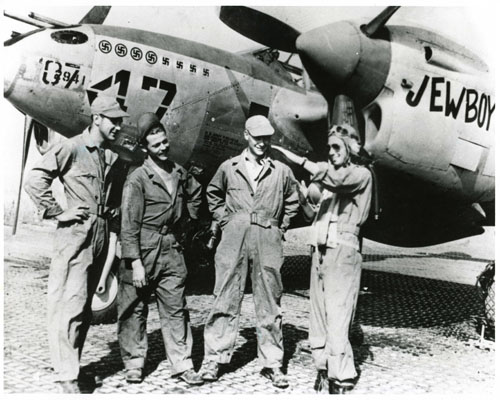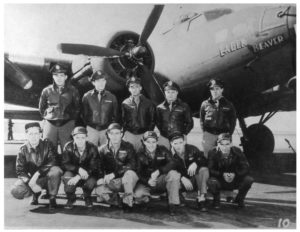(“This” post, which dates back to January of 2017, is now slightly updated: Now included below is a photographic portrait of Captain Ornell J. Stauffer, from the National Archives’ collection Photographic Prints of Air Cadets and Officers, Air Crew, and Notables in the History of Aviation – NARA RG 18-PU. I don’t know the Advanced Flying School from which (then) Lt. Stauffer graduated and received his commission, but you can read more about his life via the Genealogy Center of the Allen County Public Library of Fort Wayne, Indiana.)
(Meantime, I’m working on posts covering a variety of subjects, which – ! – I hope to eventually complete…)
________________________________________
________________________________________
One wonders what happened to the 2,700-odd Jewish servicemen after the evening of March 28, 1945 (15 Nisan 5705).
Certainly, the overwhelming majority survived the war and returned to the United States after Japan’s surrender.
Some – with a probability verging on certainty – did not.
Case in point, the image below: An Honor Roll, created by Chaplain Cedarbaum, bearing the names of sixty-five Jewish airmen who were casualties while serving in the 20th Air Force. Based on this and other information, he planned to eventually create a book about Jewish aviators who served in the 20th Air Force as crewmen in B-29 Superfortress bombers. His plans never came to fruition, at least as he expected…
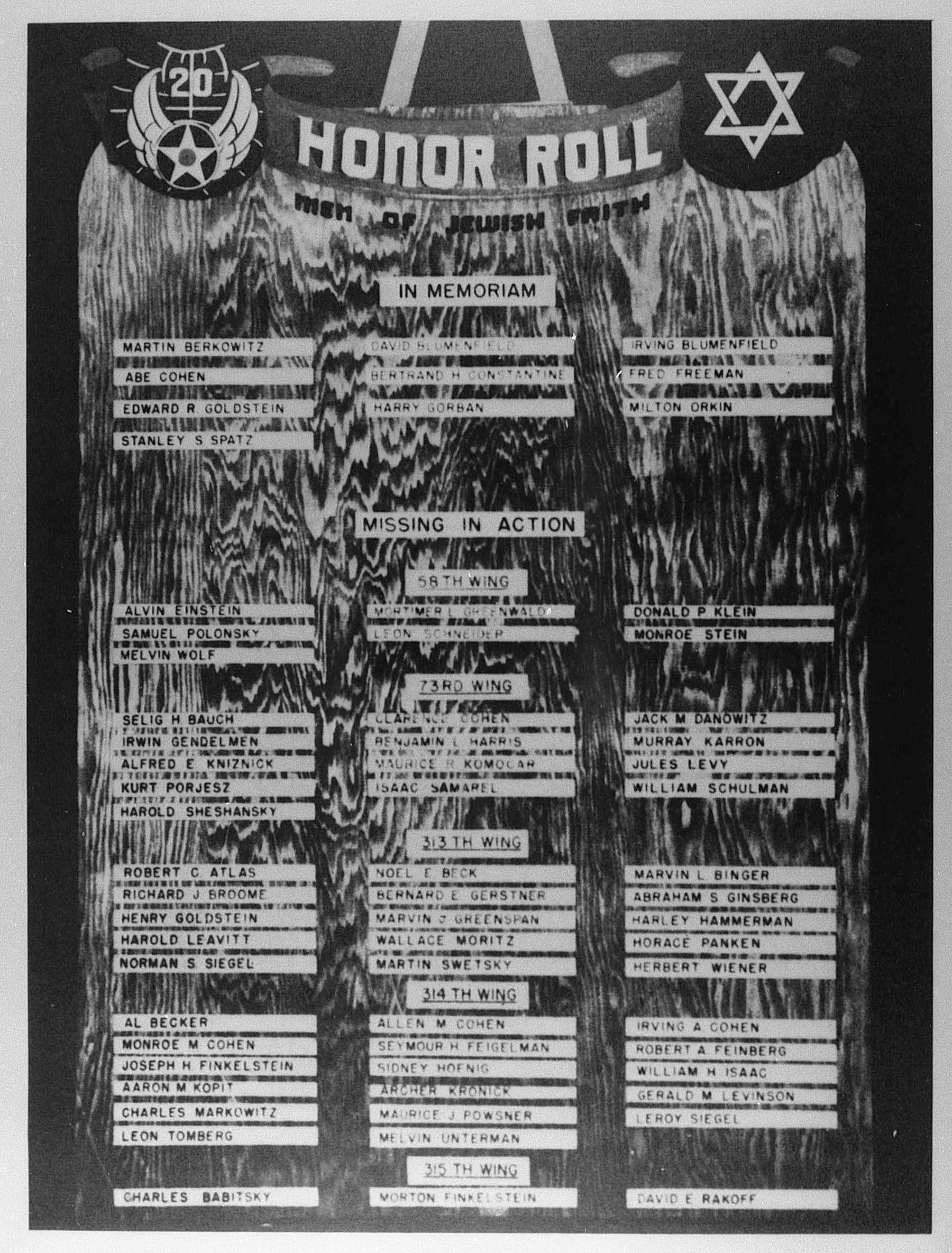 …The above photograph was received by Noah and Sadie G. Finkelstein, whose son, 2 Lt. Joseph Harold Finkelstein, a Co-Pilot in the 6th Bomb Squadron of the 29th Bomb Group, was killed during a mission to Tachiarai Airfield, Kyushu, Japan, on May 5, 1945. (1) (His name appears under the heading “314th Wing.”) The image inspired them to create their Memorial Album covering Jewish airmen who were casualties – killed or missing – in the 20th Air Force. As recorded by Noah in the book’s forward, “I decided to attempt to obtain biographies of all those whose names appeared on the plaque, and to publish an album to their memories.”
…The above photograph was received by Noah and Sadie G. Finkelstein, whose son, 2 Lt. Joseph Harold Finkelstein, a Co-Pilot in the 6th Bomb Squadron of the 29th Bomb Group, was killed during a mission to Tachiarai Airfield, Kyushu, Japan, on May 5, 1945. (1) (His name appears under the heading “314th Wing.”) The image inspired them to create their Memorial Album covering Jewish airmen who were casualties – killed or missing – in the 20th Air Force. As recorded by Noah in the book’s forward, “I decided to attempt to obtain biographies of all those whose names appeared on the plaque, and to publish an album to their memories.”
So far as I know, Noah and Sadie’s book is almost unique, for it is one of the very few monographs giving detailed biographies of American Jewish military casualties – in the context of a specific time frame, activity, and theater of war – that appeared during the twentieth century.
Some Jewish periodicals, such as the South African Jewish Times, and, the Jewish Criterion (Pittsburgh, Pa.) allocated special sections at the war’s end for comprehensive photographic and biographical coverage of Jewish military casualties, but this material was never translated into books. On the opposite end of the spectrum, Volume Two of the 1947 publication American Jews in World War II, by I. Kaufman, presents state-by-state lists of the names of American Jewish servicemen who received awards for military service, or, who were casualties (wounded, injured, or killed; the book does not specifically identify men who were POWs). The entries in this volume are limited to a man’s name, rank, city of residence, and military awards, being derived from information recorded on National Jewish Welfare Board – Bureau of War Records Master Index Cards.
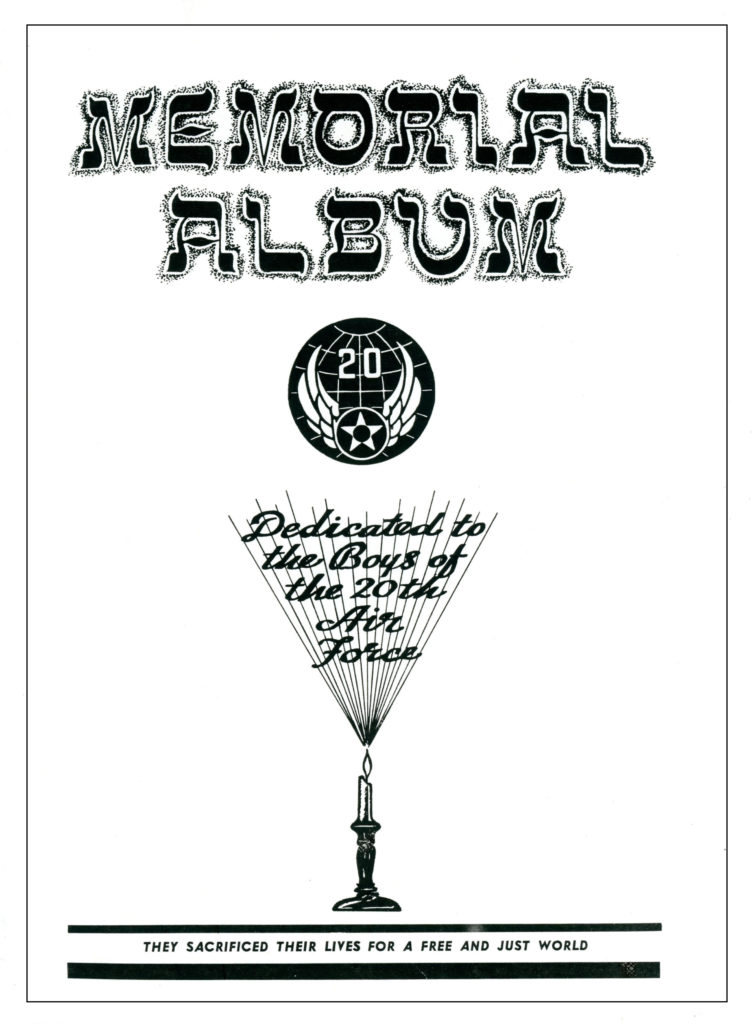 Cover page of the Finkelstein’s Memorial Album, “Dedicated to the Boys of the 20th Air Force”.
Cover page of the Finkelstein’s Memorial Album, “Dedicated to the Boys of the 20th Air Force”.
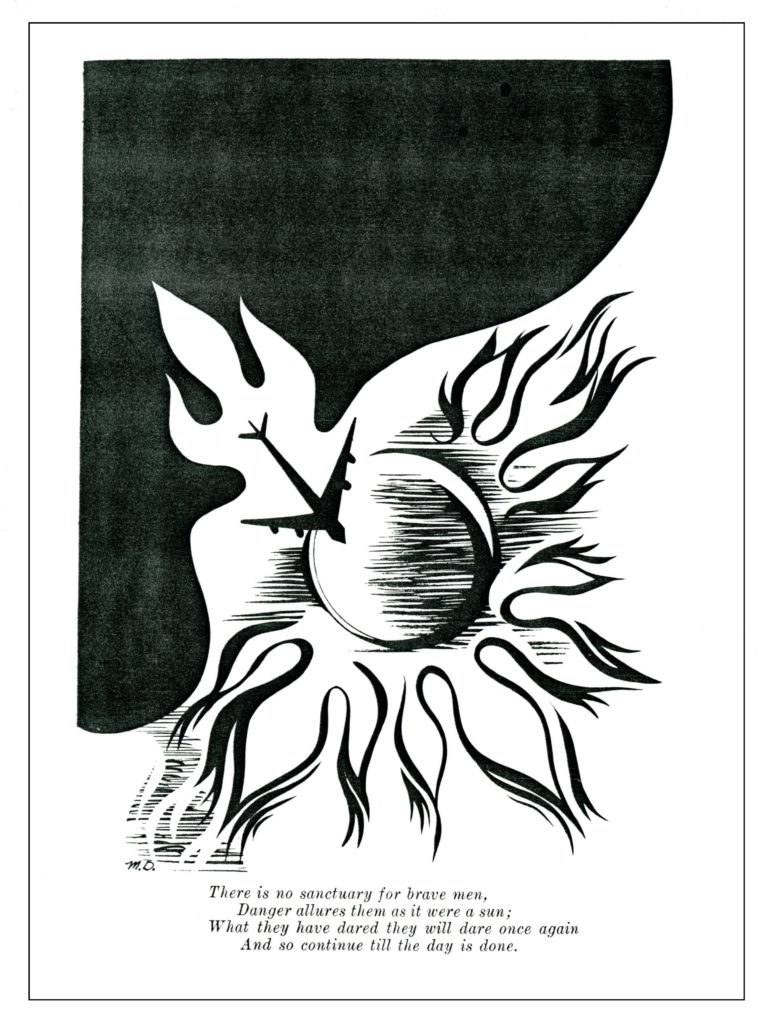 A stylized aircraft flies towards a burning sun: A brief introductory poem by Sadie Finkelstein on page 4.
A stylized aircraft flies towards a burning sun: A brief introductory poem by Sadie Finkelstein on page 4. 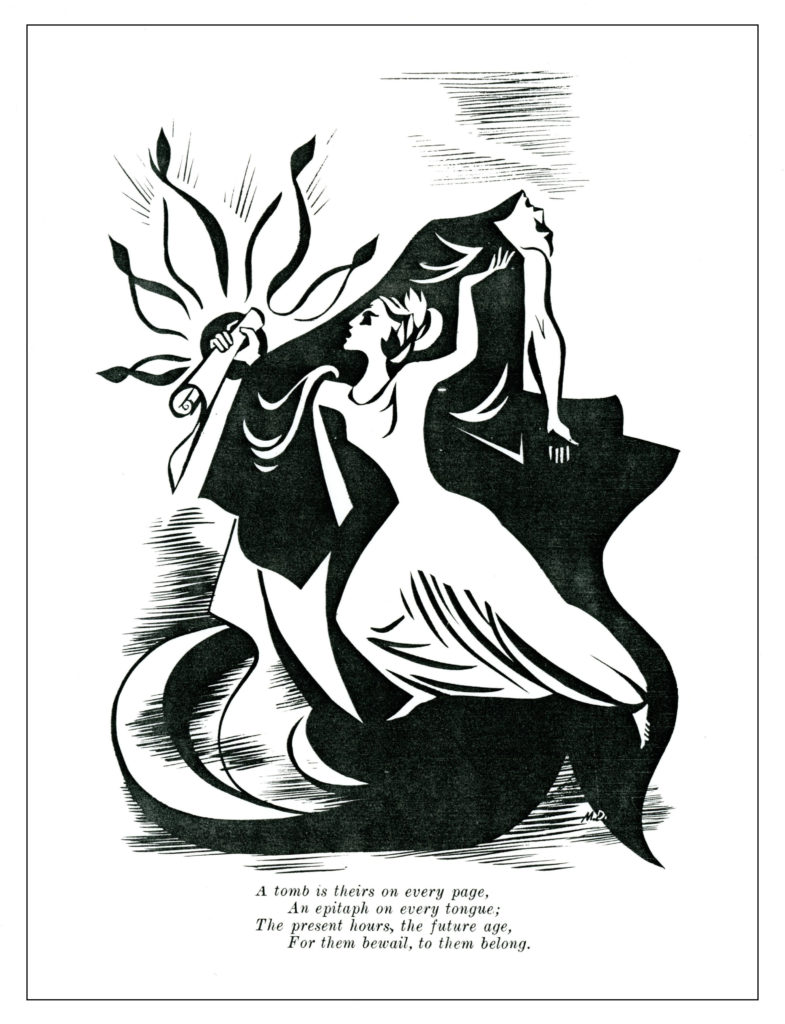 Sadie composed other poetry for her book. This comprised three other four-line poems with allegoric illustrations (the one shown above is from page 16), and, two full-length poems in Yiddish. The latter include English translations by Paul Monroe, and, Ruth Kaswan.
Sadie composed other poetry for her book. This comprised three other four-line poems with allegoric illustrations (the one shown above is from page 16), and, two full-length poems in Yiddish. The latter include English translations by Paul Monroe, and, Ruth Kaswan.
Notice that this powerful image – probably in pen and ink – is signed by “M.D.”, who also created the preceding illustration. Unfortunately, “M.D.’s” full name is not given in the text.
____________________
Unknown at the time to Chaplain Cedarbaum, among the sixty-five men whose names appear on the plaque, seven would survive as Prisoners of War (POWs). Their names, dates of capture, and crew positions follow:
Einstein, Alvin J., S/Sgt. – June 22, 1945 – Gunner (Central)
Ginsberg, Abraham Saul, Sgt. – May 29, 1945 – Gunner (Right)
Greenwald, Mortimer L., Sgt. – August 2, 1945 – Gunner
Leavitt, Harold F., S/Sgt. – May 26, 1945 – Radar Operator
Moritz, Wallace, 2 Lt. – May 29, 1945 – Navigator
Siegel, LeRoy, Sgt. – April 7, 1945 – Gunner
Unterman, Melvin, Capt. – May 26, 1945 – Bombardier
Among those who did not survive, the majority were never found, due to the combination of physical circumstances and / or locations in which their aircraft were lost. Their names of most are commemorated at the Tablets of the Missing at the Honolulu Memorial, in Honolulu, Hawaii.
Of the sixty five, the Finkelsteins’ book presents biographies and photographs for twenty-four. They are:
Bauch, Selig H., Sgt. – Radar Operator
Berkowitz, Martin, S/Sgt. – Radio Operator
Binger, Marvin Louis, Sgt. – Gunner (Right)
Broome, Richard Jerome, Sgt. – Flight Engineer
Cohen, Abe, PFC (Not actually an air crewman; died while trying to rescue a comrade from a burning building.)
Cohen, Monroe Melvin, F/O – Navigator
Feinberg, Robert Alvin, 2 Lt. – Radar Operator
Finkelstein, Joseph Harold, 2 Lt. (Their son) Co-Pilot
Greenspan, Marvin Jerome, Cpl. – Gunner (Right)
(Shot down over Japan on 4/15/45 (his first mission); captured immediately; murdered shortly after under direction and instigation of Second Lieutenant Ippei Tamura.)
Harris, Benjamin L., 2 Lt. – Flight Engineer
Hoenig, Sidney, F/O – Bombardier
Klein, Donald Philip, S/Sgt. – Radar Operator
Kronick, Archer S. (Asher Simcha bar Yoel), Sgt. – Gunner (Central)
Levinson, Gerald M., 2 Lt. – Flight Engineer
Levy, Jules, 2 Lt. – Navigator
Orkin, Milton, 2 Lt. – Navigator
Porjesz, Kurt, S/Sgt. – Radio Operator
Powsner, Maurice J., F/O – Bombardier
Schneider, Leon, 2 Lt. – Bombardier
Sheshansky, Harold, S/Sgt. – Gunner (Central)
Siegel, Norman Sydney, 2 Lt. – Navigator
Stein, Monroe, 1 Lt. – Bombardier / Navigator
Tomberg, Leon,1 Lt. – Bombardier
Weiner, Herbert Coften, 2 Lt. (Actually, a casualty in Australia with the 5th Air Force)
The sixty-five names alluded to above represent a portion of Jewish servicemen who were casualties in the 20th Air Force. The total number stands substantially higher and includes six other POWs. The names and dates of capture of the latter are:
Levine, Joseph, 1 Lt. – December 14, 1944 – Bombardier
Levine, Stanley H., 2 Lt. – August 8, 1945 – Flight Engineer
Newman, Irving Sidney, 2 Lt. – August 20, 1944 – Navigator
Paul, Chester E., 1 Lt. – December 14, 1944 – Co-Pilot
Presender, Robert Eugene, 1 Lt. – March 2, 1945 – Navigator
Sellz, Norman, S/Sgt. – April 7, 1945 – Radar Operator (Sole survivor of his crew)
Many more names could be presented, but this list will suffice, for now.
Perhaps better to let one man symbolically speak for all – for those few who returned; for the many who did not: Irving S. Newman, at a reunion of the 468th Bomb Group in September of 1995.
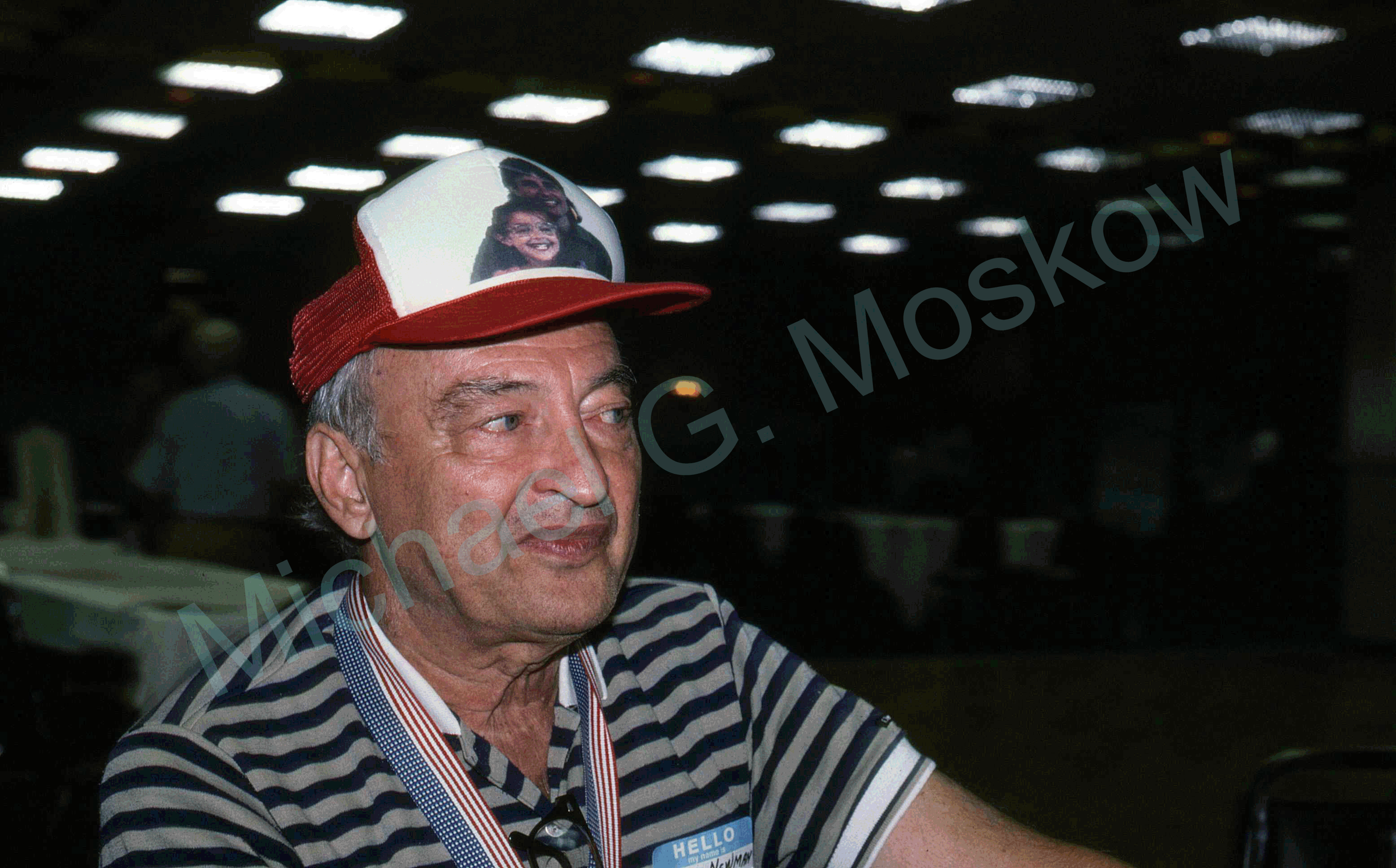 From Dorchester, Massachusetts, Irving was a navigator, and one of three survivors (along with the flight engineer and radar operator) of Calamity Sue, a 468th Bomb Group B-29 piloted by Captain Ornell J. Stauffer. Calamity Sue was lost on a mission to Yawata, Japan, on August 20, 1944 (the crew’s second combat mission) when a nearby B-29, the Gertrude C, was deliberately rammed by a Japanese fighter, debris from the disintegrating B-29 striking and mortally damaging Stauffer’s aircraft.
From Dorchester, Massachusetts, Irving was a navigator, and one of three survivors (along with the flight engineer and radar operator) of Calamity Sue, a 468th Bomb Group B-29 piloted by Captain Ornell J. Stauffer. Calamity Sue was lost on a mission to Yawata, Japan, on August 20, 1944 (the crew’s second combat mission) when a nearby B-29, the Gertrude C, was deliberately rammed by a Japanese fighter, debris from the disintegrating B-29 striking and mortally damaging Stauffer’s aircraft.
A portrait of the Stauffer crew, from Irving Newman’s collection, is show below. The photograph was taken at Smoky Hill Army Air Field (later Schilling Air Force Base), Salina, Kansas, in February of 1944. The men stand before “Eager Beaver”, a B-17F Flying Fortress. (Photo c/o Irving Newman)
Rear row, left to right:
Pilot – Captain Ornell J. Stauffer (KIA)
Co-Pilot – Lieutenant Jimmie Wine (bailed out, later killed)
Navigator – Second Lieutenant Irving S. Newman (survived – POW)
Bombardier – Second Lieutenant Ben R. Bloom (KIA)
Flight Engineer – Second Lieutenant Austin C. Shott (survived – POW)
Front row, left to right:
S/Sgt. James A. O’Brien – Gunner (Left Blister) (KIA)
T/Sgt. Walter A. Dansby – Radio Operator (Survived – POW)
S/Sgt. Clinton A. Martin – Gunner (Central Fire Control) (KIA)
Sgt. Raymond J. Keelan – Radar Operator (KIA)
S/Sgt. Michael J. Karlovich – Gunner (Right Blister) (KIA)
T/Sgt. Robert W. Bonner – Gunner (Tail) (KIA)
Missing Air Crew Report 9685, covering the loss of Captain Stauffer’s B-29 (42-6368 – Calamity Sue), includes the following postwar statement by T/Sgt. Dansby:
“I will tell the story as far as I how it, however, I don’t know much. We were flying at 26,000 ft. and suddenly something hit us. I was knocked out of my seat on my back. I met Capt. Dean, a pilot on TDY. He tells me the following: We were in the No. 4 spot in a four plane formation and a Jap fighter approached us. He misjudged our speed and before he could pull away he rammed our formation leader, Lt. Col. Clinkscales. The wreckage from the plane hit the plane I was in and knocked off our tail assembly. That was the Capts.’ story. After having been hit, we went into a spin. The co-pilot [Wine] let the landing gear down and he and the engineer [Shott] opened the nose wheel door. The engineer bailed out at once at I would guess 20,000 ft. The navigator [Newman] who was squatting between the pilot [Stauffer] & co-pilot with his maps had to run back & put his parachute on. He bailed out about 14,000 ft. and after I got back on my feet I bailed out at about 3,000 ft. Although I was last out, I saw the navigator coming down after I hit the ground. I finally met up with him and they captured us about ten minutes later. After staying in solitary confinement for 4 months I was sent to a prison camp. Later I met up with the rest of the men who was shot down the same day. Col. Carmichael, Richard, was among the men who were brought in later, but, except for the three of my crew who I knew bailed out, I never saw any of the remaining eight of the crew. I heard a report after the war was over that six parachutes were seen to come from my plane – but none of them ever showed up at the prison, which was named Omori Prison between Tokyo & Yokohama, camp where I was. It seems that this camp was the staging area for B-29 airmen. Except for a few scattered around in China & other parts of Japan B-29 prisoners were brought to this camp. At war’s end there was almost 150 B-29 men in this camp, but none of our missing crewmen ever showed up.”
________________________________________
Captain (then Flying Cadet) Stauffer’s portrait, from NARA’s Photographic Prints of Air Cadets and Officers, Air Crew, and Notables in the History of Aviation – NARA RG 18-PU.
 ________________________________________
________________________________________
Like many veterans of the Second World War, Irving wrote an account of his experiences. Intended for his family, and in a symbolic sense simply for the historical record – to make a historical record of the past for its own sake – Irving actually began this process very soon after being liberated from captivity in Omori, Japan, in 1945. As he recounted, “This book was started in September of 1945, aboard the USS Yarmouth. She was a little out of her accustomed territory. Boston to Nova Scotia was her regular run, but here she was come to take me home from my Pacific war. I wrote laboriously, telling who, what, when and where, but never why; that always escaped me.”
The book is arranged chronologically and encompasses such topics as Irving’s pre-war life in the Boston area, his training as a bombardier, and navigator; his relationships with other airmen, particularly his crew members and fellow POWs; being Jewish in the military in the 1940s (though not a central thrust of the book); the loss of Calamity Sue, his capture, and the realities of interrogation by the Japanese; life as a prisoner of war.
Given the immediacy of its composition, the book is a work of great clarity, detail, directness, and near-complete frankness. As Irving himself implied, there is genuinely and intentionally very little “why” in the book in the way of discussion of deeper religious or philosophical issues.
Which, perhaps, when pondering the names above – why some men returned,; why some did not – is just as well.
We all have to answer such questions in our own way.
Here is a brief answer from Irving, speaking for his father, Harry Newman:
____________________
(1) Their B-29, serial 42-93953 and commanded by 1 Lt. Ralph E. Miller, was shot down by Petty Officer Toru Kurita of the 343rd Kokutai, who was flying a N1K2-J Shiden Kai fighter plane. The crew consisted of:
Pilot: 1 Lt. Ralph E. Miller (Eaton Rapids, Mi.)
Co-Pilot: 2 Lt. Joseph H. Finkelstein (Los Angeles, Ca.)
Navigator: 2 Lt. Charles C. Winder (Salt Lake City, Ut.)
Bombardier: 1 Lt. Clyde M. Roush (Neosho Rapids, Ks.)
Flight Engineer: T/Sgt. William H. Chapman (Calhoun, Ga.)
Radar Operator: 2 Lt. Jack M. Berry (Atlanta, Ga.)
Radio Operator: Sgt. Jack V. Dengler (Danville, Il. / Salt Lake City, Ut.)
Gunner (Central): Sgt. Albert R. Howard (Cullman, Ak.)
Gunner (Left): Pvt. Merlin R. Calvin (Saint Louis, Mo.)
Gunner (Right): Cpl. Clark B. Bassett, Jr. (Son of Clark B. and Bonnie W. Bassett, of 202 Niagara St., North Tonawanda, N.Y.)
Gunner (Tail): Cpl. Irving A. Corliss (Somersworth, N.H.)
“No eventual”, because five men did survive the aircraft’s shoot-down, by parachuting. They were 2 Lt. Berry, Sgt. Dengler, Cpl. Corliss, and Pvt. Calvin. All captured uninjured, they were murdered – while prisoners of war – on June 20, 1945. The fifth crewman, Cpl. Clark B. Bassett, Jr., severely wounded and unconscious, was parachuted from the plane by those men, and died of his wounds not long after landing. He is the only member of this crew who has a place of burial. (Acacia Cemetery, North Tonawanda, N.Y.)
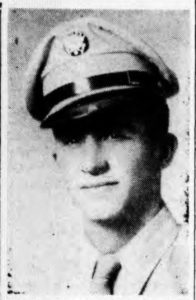
Corporal Clark B. Bassett, Jr., from the North Tonawanda Evening News of December 27, 1948.
The plane’s other crewmen – Miller, Finkelstein, Winder, Roush, Chapman, and Howard – were presumably still aboard the aircraft when it crashed at sea, at a place still – and probably forever – unknown.
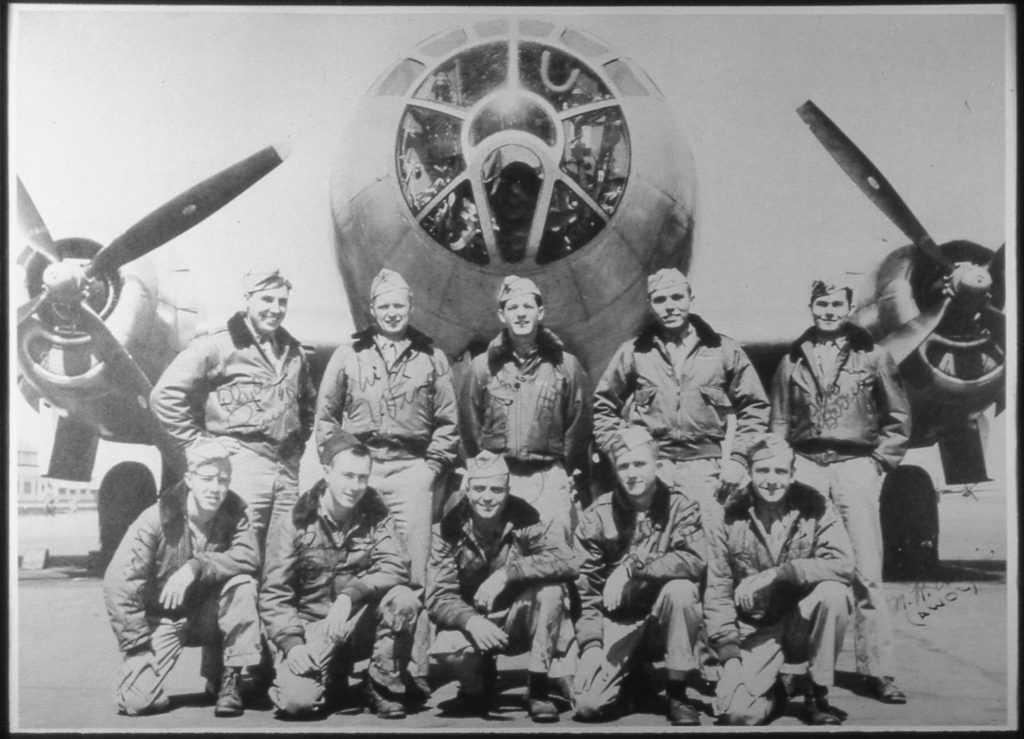 Rear row: Roush, Winder, 1 Lt. Paul E. Remmetter (Killed in Action April 16, 1945; replaced by Lt. Miller), Finkelstein, Berry
Rear row: Roush, Winder, 1 Lt. Paul E. Remmetter (Killed in Action April 16, 1945; replaced by Lt. Miller), Finkelstein, Berry
Front row: Howard?, Dengler, Chapman or Corliss, Bassett
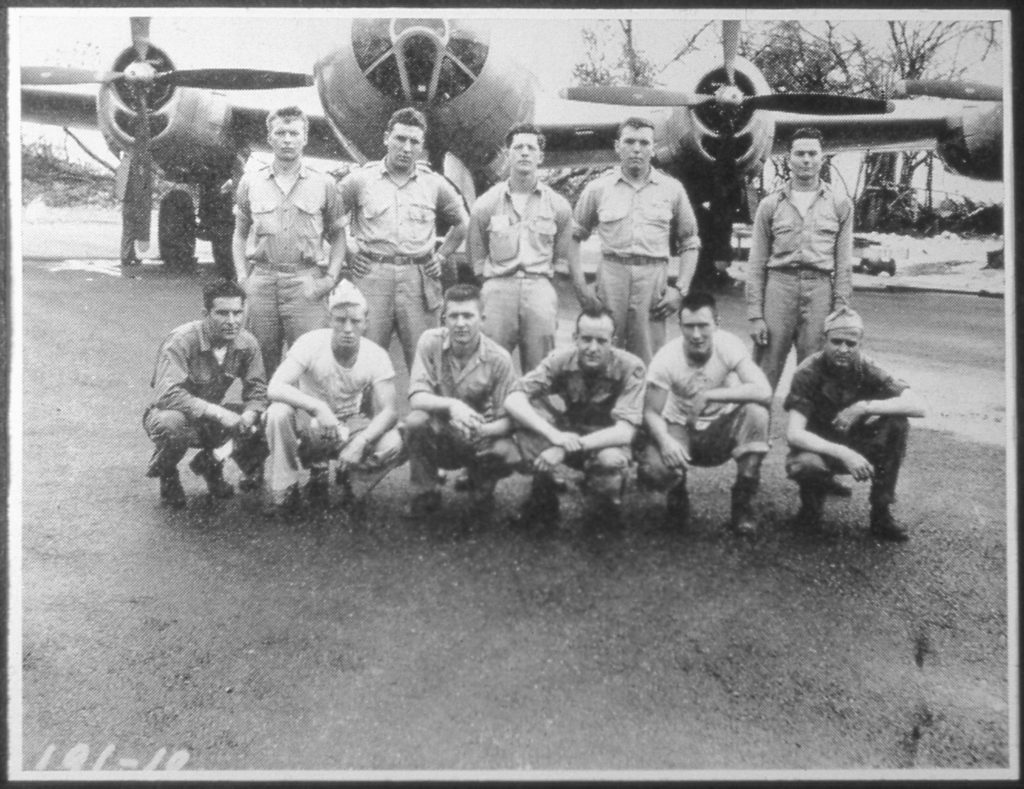 Rear row, left to right: Roush, Winder, Remmetter, Finkelstein, Berry
Rear row, left to right: Roush, Winder, Remmetter, Finkelstein, Berry
Front row, left to right: Howard, Dengler, Chapman, Bassett, Corliss, Calvin
1/6/17
1077
